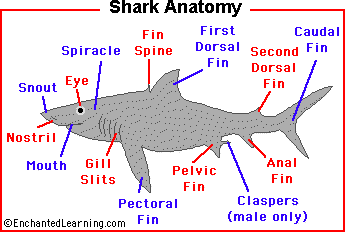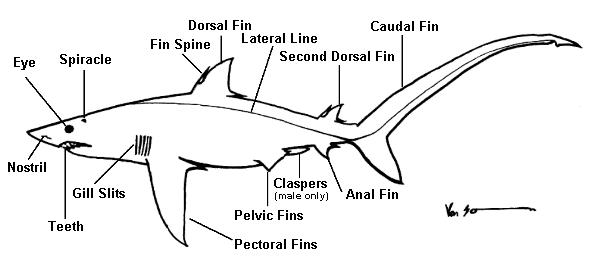Source (google.com.pk)
Tiger Shark Anatomy Biography
GENERAL ANATOMY
Sharks are fish that have no bones, only cartilage. They have 5-7 gills (without gill covers, operculum) in front of their pectoral fins (on both sides). Shark tails are asymmetrical; the top lobe of tail is larger than the bottom lobe. The shark's jaw is not fused to the braincase and can enlarge to eat very large prey. Sharks have no swim bladder for buoyancy (like the bony fishes); an oily liver aids buoyancy. Sharks have an advanced electroreceptive system that detects slight electrical fields.
The teeth and skin are modified placoid scales. A spiracle (a special gill slit that supplies oxygen directly to the eyes and brain) is present in front of the first gill. Sharks' teeth are replaceable when they've broken or worn out. Their intestines are short and compact and have an unusual structure; a spiral valve (shaped like a spiral staircase) fills the cylindrical intestines and allows absorption of the food in a short span of intestine.
Tiger Shark Teeth and Anatomy
How will you know when a tiger shark is swimming toward you? As we mentioned, tiger sharks get their name from the tiger-like stripes and spots that are most prevalent on juveniles. The sharks are bluish-green to dark gray on top, with a yellowish or white underbelly [source: Knickle].
When they're born, tiger sharks measure only 20 inches to 30 inches in length (51 centimeters to 76 centimeters) [source: MarineBio]. But they get much bigger: The full-grown tiger shark reaches 10 feet to 14 feet in length (3 meters to 4 meters) and weighs between 850 pounds and 1,400 pounds (385 kilograms and 635 kilograms) [source: National Geographic]. Larger tiger sharks can reach 17 feet (5 m) and 2,000 pounds (907 kg) [source: Knickle]. While not the biggest fish in the sea -- for comparison, the largest shark, the whale, tips the scales at 75,000 pounds (34,019 kg) and measures 65 feet (20 m) [source: MarineBio] -- the tiger shark does rank near the top of the list.
Tiger sharks are generally considered slow and sluggish, but their fins are capable of fast bursts of energy when they're tracking prey. Like other sharks, the tiger shark moves with its fins. The main factors in mobility are the pectoral fin and the caudal fin, or the tail. The dorsal fins on top help the tiger shark change directions. Like other shark species, they also have vibration detectors along their sides that help them to detect movement in the water. Tiger sharks have very thick hides, once described by a scientist as six to 10 times the strength of an ox hide [source: Tennesen].
The tiger shark has a wide mouth compared to other sharks in its family, and inside the tiger shark's blunt snout is something that really sets it apart: its teeth. Each tooth is almost like having several teeth in one space; the sharp, primary cusp extends down, ready to tear into prey. Along the primary cusp, or point, are tiny little serrated cusplets that can saw into the food. The tiger shark has identical upper and lower jaws, and with all these serrated teeth, there's really nothing that the tiger shark can't eat. Even the tough shells of sea turtles are no match for the tiger shark.

Tiger Shark Anatomy

Tiger Shark Anatomy

Tiger Shark Anatomy

Tiger Shark Anatomy

Tiger Shark Anatomy

Tiger Shark Anatomy

Tiger Shark Anatomy

Tiger Shark Anatomy

Tiger Shark Anatomy
Tiger Shark Anatomy Biography
GENERAL ANATOMY
Sharks are fish that have no bones, only cartilage. They have 5-7 gills (without gill covers, operculum) in front of their pectoral fins (on both sides). Shark tails are asymmetrical; the top lobe of tail is larger than the bottom lobe. The shark's jaw is not fused to the braincase and can enlarge to eat very large prey. Sharks have no swim bladder for buoyancy (like the bony fishes); an oily liver aids buoyancy. Sharks have an advanced electroreceptive system that detects slight electrical fields.
The teeth and skin are modified placoid scales. A spiracle (a special gill slit that supplies oxygen directly to the eyes and brain) is present in front of the first gill. Sharks' teeth are replaceable when they've broken or worn out. Their intestines are short and compact and have an unusual structure; a spiral valve (shaped like a spiral staircase) fills the cylindrical intestines and allows absorption of the food in a short span of intestine.
Tiger Shark Teeth and Anatomy
How will you know when a tiger shark is swimming toward you? As we mentioned, tiger sharks get their name from the tiger-like stripes and spots that are most prevalent on juveniles. The sharks are bluish-green to dark gray on top, with a yellowish or white underbelly [source: Knickle].
When they're born, tiger sharks measure only 20 inches to 30 inches in length (51 centimeters to 76 centimeters) [source: MarineBio]. But they get much bigger: The full-grown tiger shark reaches 10 feet to 14 feet in length (3 meters to 4 meters) and weighs between 850 pounds and 1,400 pounds (385 kilograms and 635 kilograms) [source: National Geographic]. Larger tiger sharks can reach 17 feet (5 m) and 2,000 pounds (907 kg) [source: Knickle]. While not the biggest fish in the sea -- for comparison, the largest shark, the whale, tips the scales at 75,000 pounds (34,019 kg) and measures 65 feet (20 m) [source: MarineBio] -- the tiger shark does rank near the top of the list.
Tiger sharks are generally considered slow and sluggish, but their fins are capable of fast bursts of energy when they're tracking prey. Like other sharks, the tiger shark moves with its fins. The main factors in mobility are the pectoral fin and the caudal fin, or the tail. The dorsal fins on top help the tiger shark change directions. Like other shark species, they also have vibration detectors along their sides that help them to detect movement in the water. Tiger sharks have very thick hides, once described by a scientist as six to 10 times the strength of an ox hide [source: Tennesen].
The tiger shark has a wide mouth compared to other sharks in its family, and inside the tiger shark's blunt snout is something that really sets it apart: its teeth. Each tooth is almost like having several teeth in one space; the sharp, primary cusp extends down, ready to tear into prey. Along the primary cusp, or point, are tiny little serrated cusplets that can saw into the food. The tiger shark has identical upper and lower jaws, and with all these serrated teeth, there's really nothing that the tiger shark can't eat. Even the tough shells of sea turtles are no match for the tiger shark.
Tiger Shark Anatomy

Tiger Shark Anatomy

Tiger Shark Anatomy

Tiger Shark Anatomy
Tiger Shark Anatomy
Tiger Shark Anatomy

Tiger Shark Anatomy

Tiger Shark Anatomy

Tiger Shark Anatomy

Tiger Shark Anatomy
No comments:
Post a Comment